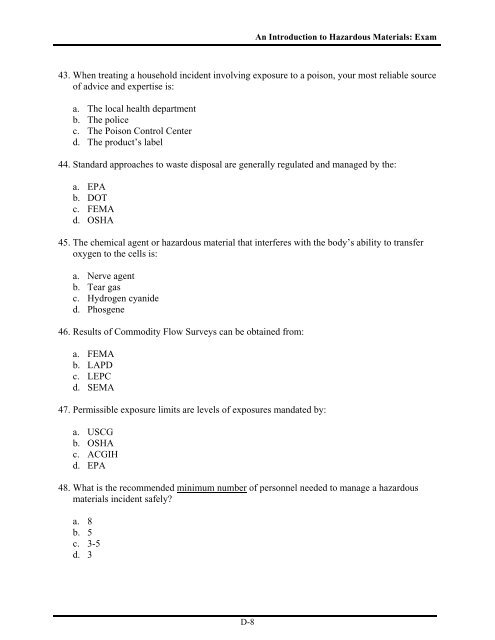An Introduction to Hazardous Materials: Exam - Emergency ...
An Introduction to Hazardous Materials: Exam - Emergency ...
An Introduction to Hazardous Materials: Exam - Emergency ...
Create successful ePaper yourself
Turn your PDF publications into a flip-book with our unique Google optimized e-Paper software.
<strong>An</strong> <strong>Introduction</strong> <strong>to</strong> <strong>Hazardous</strong> <strong>Materials</strong>: <strong>Exam</strong><br />
43. When treating a household incident involving exposure <strong>to</strong> a poison, your most reliable source<br />
of advice and expertise is:<br />
a. The local health department<br />
b. The police<br />
c. The Poison Control Center<br />
d. The product’s label<br />
44. Standard approaches <strong>to</strong> waste disposal are generally regulated and managed by the:<br />
a. EPA<br />
b. DOT<br />
c. FEMA<br />
d. OSHA<br />
45. The chemical agent or hazardous material that interferes with the body’s ability <strong>to</strong> transfer<br />
oxygen <strong>to</strong> the cells is:<br />
a. Nerve agent<br />
b. Tear gas<br />
c. Hydrogen cyanide<br />
d. Phosgene<br />
46. Results of Commodity Flow Surveys can be obtained from:<br />
a. FEMA<br />
b. LAPD<br />
c. LEPC<br />
d. SEMA<br />
47. Permissible exposure limits are levels of exposures mandated by:<br />
a. USCG<br />
b. OSHA<br />
c. ACGIH<br />
d. EPA<br />
48. What is the recommended minimum number of personnel needed <strong>to</strong> manage a hazardous<br />
materials incident safely?<br />
a. 8<br />
b. 5<br />
c. 3-5<br />
d. 3<br />
D-8

















